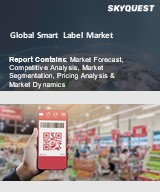
Report ID: SQSG45E2017

Report ID:
SQSG45E2017 |
Region:
Global |
Published Date: February, 2024
Pages:
157
|
Tables:
98 |
Figures:
76
Smart Label Market Driver
To forecast how SmartLabel would be adopted in the future by the industry, GMA conducted member polls. 36 businesses joined the project at the start, promising to label around 34,000 products on the market by the end of 2017. 48 additional businesses agreed to join the initiative, but they required more time to create an implementation schedule.
Smart Label Market Restraint
Our industry expert will work with you to provide you with customized data in a short amount of time.
REQUEST FREE CUSTOMIZATIONWant to customize this report? This report can be personalized according to your needs. Our analysts and industry experts will work directly with you to understand your requirements and provide you with customized data in a short amount of time. We offer $1000 worth of FREE customization at the time of purchase.

Report ID: SQSG45E2017